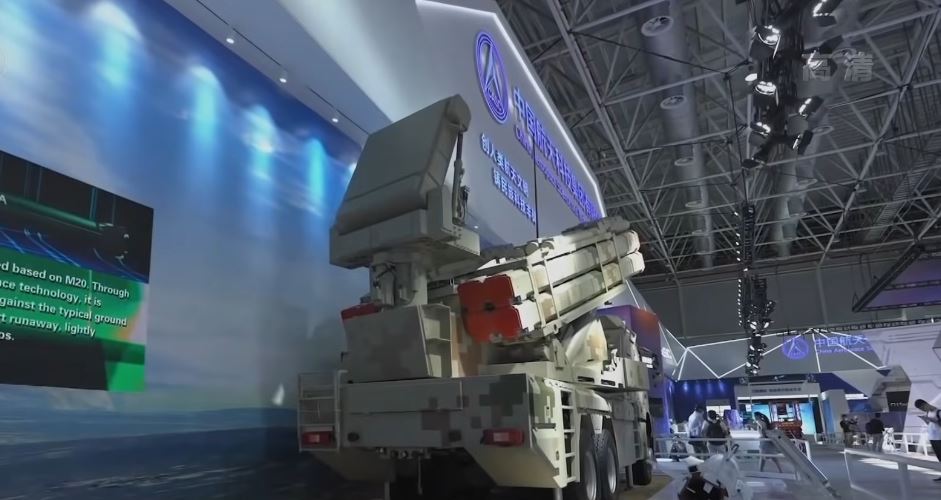China Now Sells All Kinds Of SAMs

An overabundance of sophisticated weapon systems became the defining characteristic of Air Show China 2021 that took place from September 28 until October 3. Due to its absence in the previous year and the decline of global aviation caused by the pandemic there was a greater push for topping expectations once the new dates were set. The impact this had on the event was the unmissable presence of China’s military-industrial sector and their dazzling catalogs. The high tech manufacturer CASC used every square meter of its floor space to the utmost and garnered much needed publicity for its premier air defense weapon.
Readers will notice how CASC named its mobile SAM the LY-70 so it precedes the well-known LY-80, which is called the HQ-16 in PLA service, that has enjoyed exports to Chinese allies. The LY-70 is unique among contemporary mobile SAMs for carrying two types of missiles on its launchers. Although it appears its 6×6 transporter supports eight containers for medium-range missiles there are three additional launch tubes above each quartet. These are for short-range infrared guided missiles meant to engage low flying targets.
In an animated promotional video clip shared by Chinese media the LY-70 is able to fire on the move and identify multiple aerial objects within a 90 kilometer radius–this is how far its tracking radar works. The exact altitude and range for its missiles wasn’t revealed but the larger ones in rectangular containers are able to intercept cruise missiles and other precision guided munitions. The video clip did show the LY-70 engaging an F-16C/D and a Global Hawk UAV. Meanwhile, the smaller missiles located above the box containers are suited for taking down helicopters such as the AH-64E. Of course, these were details portrayed in an animated sequence for marketing purposes.
As a hybrid short/medium-range SAM that has interoperability with other Chinese-made air defenses the CASC LY-70 is in direct competition against Russia’s own formidable catalog of anti-aircraft systems. At least four Russian-made SAMs are under threat from the LY-70 and they are the Viking, the Buk-M2E, the Tor-M2E/E2, and the Sosna. What gives the LY-70 an edge is its ability to launch missiles on the move and its two munitions, eight medium-range missiles and six short-range missiles, that are guided by a tracking radar and a smaller EO/IR camera. The Russians don’t offer anything similar although their SAMs enjoy extensive combat records and clients in four continents. The LY-70 hasn’t been delivered anywhere outside China nor is it in service with the PLA or its branches.
But competition exists from Chinese manufacturers like CASIC and Norinco. The latter, for example, maintains its own short and medium-range SAMs and these can be paired with anti-aircraft artillery. It’s also possible to establish a fully networked air defense system on Chinese technology alone. By acquiring the LY-70 in sufficient numbers this plugs a gap that long-range SAMs like HQ-9/HQ-9B creates. So if a Chinese ally has acquired HQ-9/HQ-9B’s the protective umbrella they provide is enhanced by the medium-range LY-80 and the LY-70 and the last layer of defense are the short-range HQ-7/HQ-7B and the HQ-17AE while mobile guns such as the FK-2000 and the LD-2000 ensure loitering munitions and drones are unable to get through. The static formations of these air defenses are in turn protected by troops equipped with MANPADS and handheld anti-UAV jammers. A real world deployment of a layered air defense network featuring multiple weapon systems and radars spread over a territorial expanse was done in Iran this year.
China has a large enough clientele for its air defense systems by now and this decade could be very lucrative for its state-owned military-industrial sector who face no other competitors besides Russia and the United States. (India has few opportunities to export its indigenous anti-aircraft weapons and neither will Japan attempt the same.) At least five Asian countries–Bangladesh, Myanmar, Pakistan, Turkmenistan, Uzbekistan–have acquired current Chinese-made SAMs in the last 20 years and further orders may happen in the 2020s. There are glimmers of future success in Europe as non-integrated countries like Serbia have full access to Chinese military products. The Middle East is another bright spot since Western air defenses, be they French, German, or US-made, are expensive and sometimes inaccessible. The dollar value of potential exports to the Middle East, especially with end users scrambling for up-to-date air defenses, are in the low hundred millions to billions.














Comments are closed.